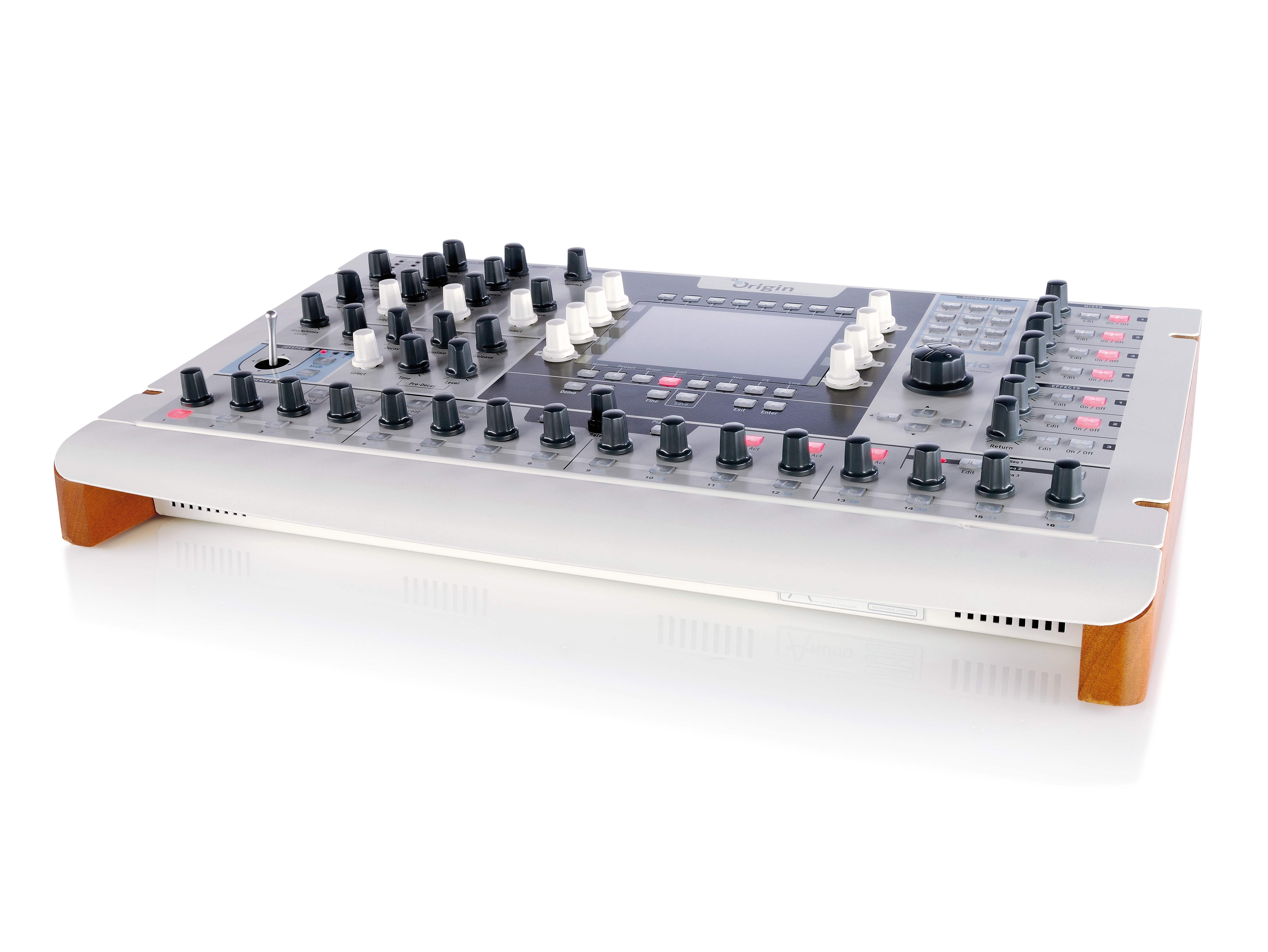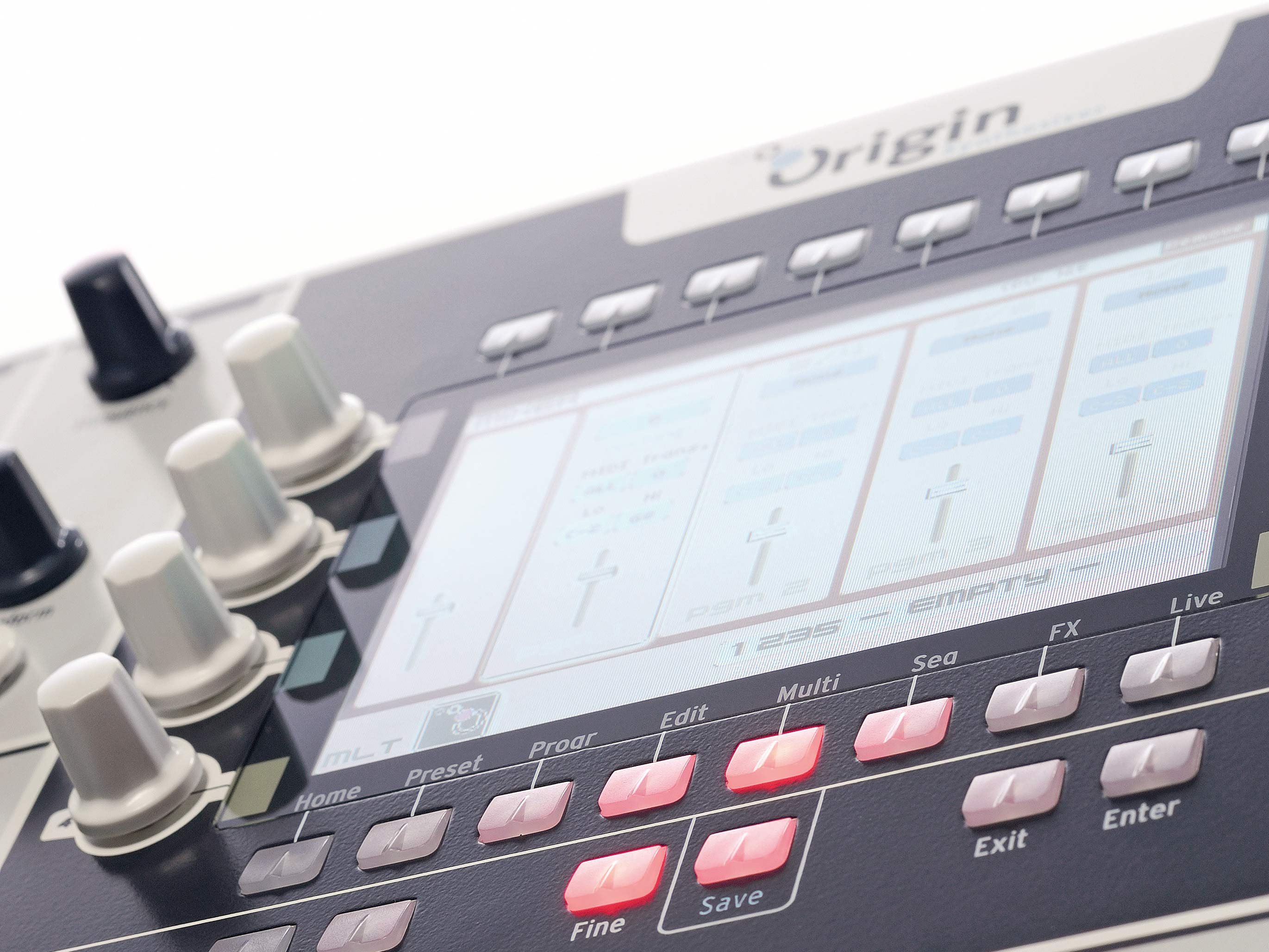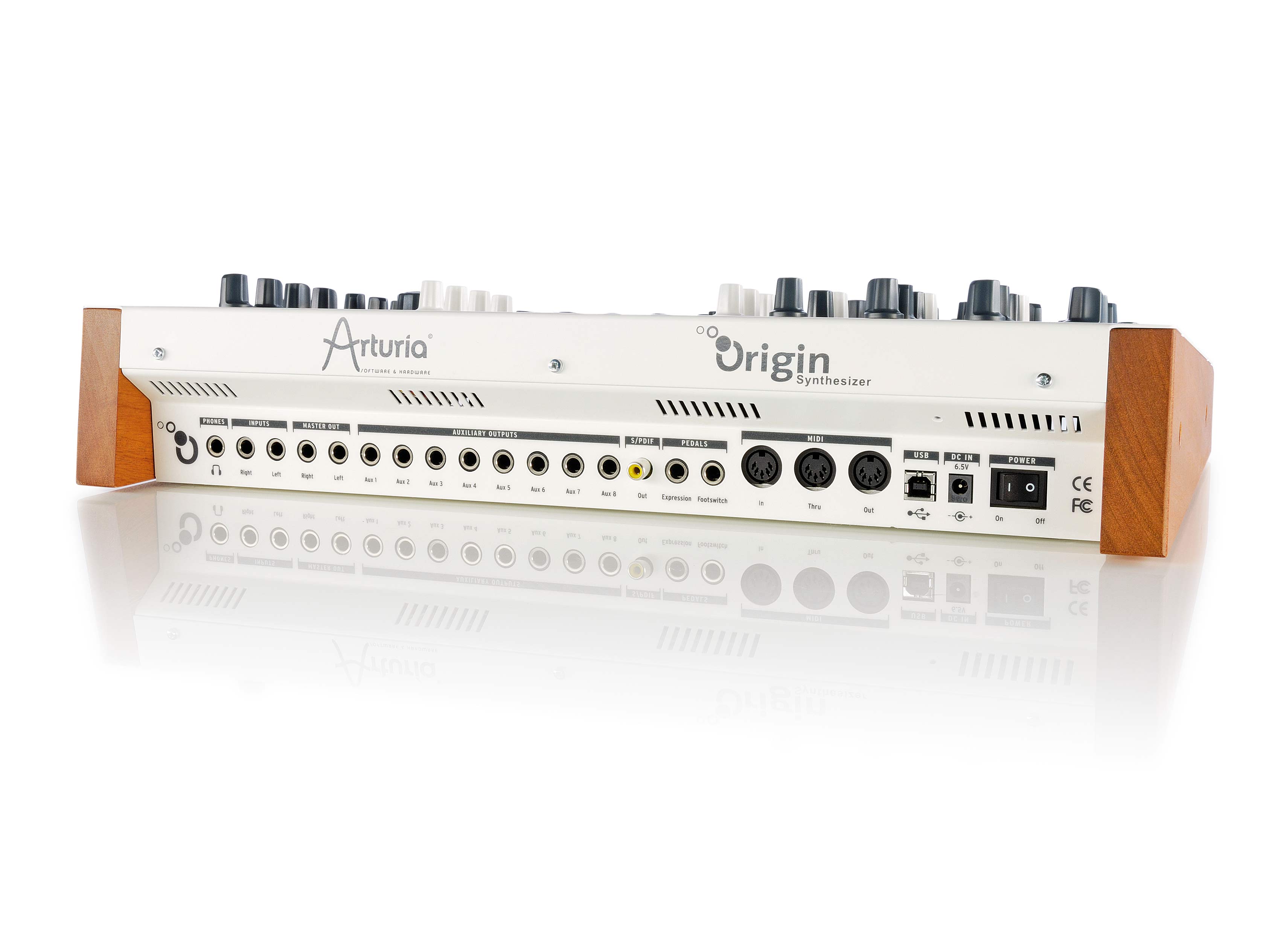MusicRadar Verdict
Origin sounds fantastic and sets a new standard in contemporary synth design.
Pros
- +
First-class, authentic analogue sound. Lots of hands-on control. Totally modular. It can be improved with software updates.
Cons
- -
Interface can feel cluttered. Only one front-panel envelope. Only the Minimoog is currently represented graphically.
MusicRadar's got your back

Origin

Origin

Origin
Announced back at the start of 2007, Origin is Arturia's first hardware synth.
Its overall look is somewhere between something you'd see monitoring heart rates in a hospital and a spaceship's control panel, with its clinical metal/plastic white case and light blue graphics and no fewer than 53 knobs, 81 red backlit buttons and even a handy XY joystick.
Origin does look very good, if a little cluttered. Trying to cram all the features of several complex software plug-ins into one hardware unit with limited space was always going to be a challenge; the interface doesn't flow as well as it perhaps could have, but Arturia has done a decent job nonetheless.
The screen gives you access to the heart of the beast and displays everything going on within the Origin in high-def, high-res full colour, though it's a shame that Arturia chose not to go with a touch screen to help navigation.
Page views
There are eight main pages for accessing all the major functions in the Origin. Page 1 (Home) is a general overview page outlining the type of sound, the sound's designer and the synth engine being used.
Page 2 (Preset) deals with preset/ multi-sound selection and searching for sounds (multis are four-way multi-timbral layered presets).
Page 3 (Program) gives a detailed overview of all the main sound-modifying parameters, such as poly and mono modes, glide/legato, TAE voice detuning (to emulate vintage analogue oscillator drift) an output mixer (that also has its own hardwired dials on the top-right of the front panel) and an FX leveller/mixer and panning controls for each output.
If that's not enough, also contained within Page 3 are tabs that lead to a 2D envelope, Galaxy Engine and LFOs. The 2D envelopes give four-stage complex looped modulations that can be driven by the joystick. The 'Galaxy' engine uses three assignable LFOs that can move along various axis and planes for cross modulating in new and unusual ways (and give continuously evolving sounds).
"Origin's overall look is somewhere between something you'd see monitoring heart rates in a hospital and a spaceship's control panel."
What's more, two continuously running mono and polyphonic LFOs can be assigned to an external controller such as a mod wheel or joystick. The LFO also includes five waves, sync, fade-in, onset delay, plus other assignable parameters such as AM/FM/PWM input and more. Complex enough for you?
Page 4 (Edit) provides access to the main nerve centre for Origin presets and this is where some very unique features are available. There are two main graphical views here - Rack and Patch.
Rack view makes it easy to see the building blocks of your sound as moveable rack modules. Patch View, meanwhile, displays the various modular components within a preset and the connections between them as colour coded patch leads. Modulation is shown green, audio red and trigger yellow.
This helps greatly in visualising the routing arrangements within a preset. Modules can be added, removed, moved or changed at the touch of a button in both Rack and Patch views.
The Origin also has a useful feature called Auto Connect that maintains all the vital connections between modules so that sound always appears at the outputs even when you aren't quite sure what's connected.
Mix and match
By swapping modules around, you can really start to hear what the different combinations sound like with only a couple of button presses. Using the main round dial for editing parameters and navigating pages/ functions (which is also a select button) makes editing/navigating straightforward, though a mouse option would have been the business.
Modules from the four main engine types (CS-80V, Minimoog V, Jupiter-8V, and ARP2600 V) can be selected and - if you're worried that things might be a little too analogue for you - Arturia have even included a Wavetable Oscillator module, loaded up with thousands of pristine digital Prophet VS wavetables.
All can be selected and combined in new ways for never-before-heard sounds, which is the real key to the Origin's appeal.
For example, you can mix any combination of oscillators and filters until the 32-note polyphony runs out. 32 notes may seem stingy, but in practice, only massively layered CPU-heavy sounds result in noticeable note robbing.
Most combinations remain perfectly playable even when there are many oscillators and filters in residence. Also, it's worth noting the 'Origin' labelled modules on board, which are designed to lessen CPU load.
Control
The eight white dials surrounding the screen can be mapped to various functions as required in the live page. They don't correlate directly in line with functions on the screen - this is because they can be freely assigned to any parameter.
Each dial also has its own colour in the display and each parameter selected takes on the colour of the corresponding dial to help show you what tweaks what.
One major downside for tweakers and performers is that there is only one front-panel envelope. Most people would have much-preferred two - one for the amp and one for the filter.
As it stands, you have to do some menu diving and butting pressing to swap the envelope between amp and filter. This is a pain; most synths have both on their front panels for maximum performance grab-ability.
Sound
It's with great pleasure that we can tell you that the Origin sounds amazing and well worth the effort that Arturia has put into programming it. It's everything you would expect and more and should keep you occupied for many years.
Any presets that you might make can be moved between the Origin hardware version and the computer thanks to the Origin Connection software. These can then be uploaded and shared on the web. However, the option to have Origin appear in your DAW as software not yet there.
Anyone familiar with the Arturia Jupiter-8V, Moog Minimoog/Modular V and the CS-80V will feel very at home with the Origin's emulations. What is missing in the current release version of the software, though, are real graphical emulations of three of these instruments. The Minimoog does have a full graphical representation and is much easier to program as a result.
"Origin's sound quality is deep, rich, earthy and wonderfully analogue with each synth engine having its own unmistakeable character."
The Minimoog engine is also the only one that currently has the handy Template feature, which give you the option to start from pre-wired modules/osc/filt combinations/connections for maximum ease of sound setup/editing.
This feature is great for the more impatient synthesists out there. Templates for the other engines will be added in a software upgrade.
Overall, the Origin's sound quality is deep, rich, earthy and wonderfully analogue with each synth engine having its own unmistakeable character. The emulations of the ARP, Minimoog, Yamaha CS-80 and Jupiter-8 sound very close to their counterparts of yesteryear and the Prophet VS Wavetable oscillators can produce some great electric pianos and evolving bell-like pads to boot.
Downsides with the sonics are virtually non-existent, save for the filter stepping at high resonance settings. This is the only giveaway that this is a virtual analogue synth and not a pure analogue machine. Again, though, we have no doubt that this can be improved in future software updates.
Effects
The effects engine in the Origin is simple yet effective. Available types include a Chorus, Dual Phaser, Reverb, Distortion and Stereo delay. These sound just as authentic as the synth emulations and are a joy to use.
The Origin's presets sound great dry and effects only enhance the sounds further, while keeping the dry sounds' integrity intact.
A Ring-Modulator and a Bode shifter module are also included. A Bode shifter is a type of logarhythmic pitchshifter that works on individual frequencies within a chord, rather than shifting the whole pitch of a chord up or down by the same amount.
There will also be a parametric EQ and Bitcrusher added in future software updates.
Sequencing and arpeggiation
The 32-step sequencer contains three sequencers that can be assigned to control pretty much any parameter within the Origin. For example, Seq 1 could control VCO pitch, Seq 2 could control the filter/ modulations and Seq 3 audio panning and so on.
It's a great tool to use not only for standard sequence fodder but also for time-evolving pads and other sounds.
There's also a wonderful graphical interface and 16 dials that correspond to each step/accent/glide/ assignable event in a sequence. This makes editing on the fly easy as pie.
Global settings include swing and quantise and sequences can be stored in 128 user patterns. 128 preset patterns are also provided.
The arpeggiator is a simpler affair in line with vintage analogue arpeggiator designs. It contains five modes (random/up down and down/up) and has a five-octave range.
Summary
So what to make of the Origin? Well, all importantly, the sound matches and surpasses the best analogue emulations out there. It's refined yet raw.
The modulation options are astounding and it's a sound designers dream - there's just so much sonic scope. The interface sometimes gets in the way of flowing programming sessions, but if you're prepared to give it time and get your hands dirty, the Origin will repay you a thousand times over.
This is close to being the ideal all-in-one box virtual synth and we truly hope Arturia keeps on developing and improving it. At £1,899 the Origin is definitely not a cheap option - you'll have to think long and hard about whether it's really for you - but it delivers sonic versatility and results that few other hardware synths can match.
For a more detailed review of the Origin, check out the November issue of Future Music (207).
Listen to just some of the sounds we managed to coax out of the Origin:
Future Music is the number one magazine for today's producers. Packed with technique and technology we'll help you make great new music. All-access artist interviews, in-depth gear reviews, essential production tutorials and much more. Every marvellous monthly edition features reliable reviews of the latest and greatest hardware and software technology and techniques, unparalleled advice, in-depth interviews, sensational free samples and so much more to improve the experience and outcome of your music-making.
“Built from the same sacred stash of NOS silicon transistors and germanium diodes, giving it the soul – and snarl – of the original”: An octave-fuzz cult classic returns as Jam Pedals resurrects the Octaurus
What’s the buzz? Meet Yellowjacket, Cherry Audio's recreation of EDP’s trend-setting Wasp from 1978
“A fabulous trip through all eight songs by 24 wonderful artists and remixers... way beyond anything I could have hoped for”: Robert Smith announces new Cure remix album










